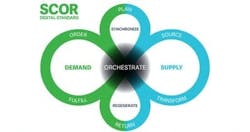New SCOR Digital Standard Updated, First Time Since 1996
The Association for Supply Chain Management (ASCM), released a new Supply Chain Operations Reference Digital Standard (SCOR DS), its most significant update since the inception of SCOR in 1996.
The new SCOR DS modernizes the open access framework to include resilience, economic, and sustainability metrics and benchmarks; process changes supporting retail, omnichannel, strategic sourcing; and overall orchestration of supply chain strategy. In addition, the new SCOR DS moves end-to-end supply chain thinking from a linear, trading partner orientation to a dynamic, asynchronous supply network that focuses on market drivers, visibility, and collaboration.
Developed by a diverse group of subject matter experts, the new SCOR DS updates processes, metrics, skills and practices to ensure coverage across multiple industries. Additionally, performance metrics and practices have been reviewed and revised to give organizations new ways to measure and improve their supply chains.
“It’s critical for us to provide supply chain professionals with the most up-to-date competencies to further their skillsets so they can thrive within the industry. " This new update to SCOR offers a more comprehensive industry standard that empowers organizations to utilize and ensure their supply chains reach their full potential,” said ASCM CEO Abe Eshkenazi, in a statement.
The original SCOR model recognizes six major processes: Plan, Source, Make, Deliver, Return and Enable. SCOR DS takes these processes further with the following updates:
- The addition of Orchestrate recognizes the importance of strategy, business rules, technology and human resources that provide an overarching direction to build a more efficient supply chain.
- Deliver was split into Order (customer orders) and Fulfill to give greater detail and emphasis to those activities, practices and metrics.
- Make became Transform, to widen its applicability to more types of manufacturing and service providers
